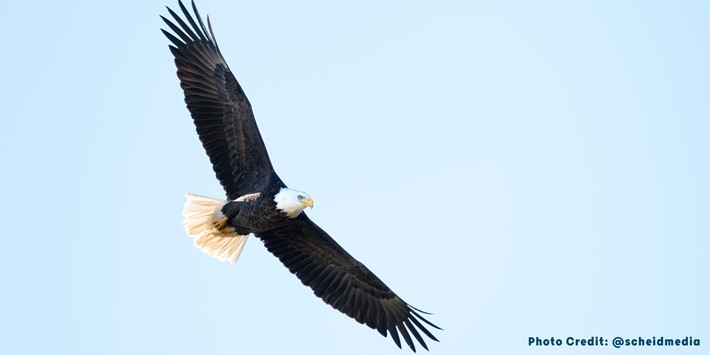
Know Before You Go: Bald Eagle Watching in Wisconsin
Once an endangered species, the bald eagle has made a grand comeback, especially here in Wisconsin. Spotting one of these majestic birds used to be a rare event, but today an eagle sighting is practically expected in many parts of the state – yet it is no less special or breathtaking. According to the National Eagle Center, Wisconsin is in the top five U.S. states for eagle populations. Read on to learn more about spotting bald eagles throughout the state.
Why do bald eagles love Wisconsin
Thanks to its abundant lakes, rivers and protected forests, eagles flock to Wisconsin in the summer to nest and raise their young. In winter, all those bodies of water – especially the flowing rivers – provide a food source for migrating eagles from farther north.
Where can I see bald eagles in Wisconsin?
In warmer seasons, eagles can be seen just about anywhere, even along the lakes in
In warmer seasons, eagles can be seen just about anywhere in Wisconsin, including along the lakes in Madison. Nest maps from the Wisconsin DNR indicate higher concentrations along the major rivers and in the state and national forest areas north of Minocqua, including the Northern Highlands-American Legion State Forest and its several lakes. In winter, as the ice forms, watch for the majestic birds to congregate around open water. The Fox Valley is also known as a popular wintering location for bald eagles, with January to early February being the best times for viewing. Stop by for Eagle Days in January for sunrise eagle viewing, children’s activities, cultural presentations and more.
The Wisconsin River below the Prairie du Sac Hydroelectric Dam is one of the best areas in the state for eagle spotting and hosts Bald Eagle Watching Days each January. Plan your visit around the event to enjoy interactive presentations, including live birds and an eagle release.
Other common areas include below the locks and dams on the St. Croix and Mississippi Rivers, at the convergence of the Chippewa and the Mississippi rivers along the Great River Road and at Wyalusing State Park.sconsin and Mississippi rivers, is another good option before the ice completely forms.
When is the best time to see eagles in Wisconsin
While eagles nest in Wisconsin in summer to raise their young, the cold months bring in an abundance of wintering eagles, and the thickening ice forces them to congregate around those open water patches for food. Additionally, the bare trees make their perches easily visible. An hour after sunrise, eagles become most active and continue to be so until mid-afternoon.
What do I need to spot bald eagles?
Eagles are large enough and that white head is bright enough that you can see them at a great distance. But even an inexpensive pair of binoculars (7x35mm) can make a big difference, and cameras with physical (not digital) zoom lenses can produce better photos. Be sure to learn to identify immature eagles, which are already quite big but lack the bright white feathers on the head and tail.
How close can I get to a bald eagle?
Like any wild animal, eagles like their space and tend to fly off when they see humans too close. Designated roosting sites – Ferry Bluff State Natural Area, for example – will often limit access during roosting season to keep hikers and birdwatchers from disturbing them, but viewing platforms, such as those in downtown Prairie du Sac, remain a good option. The platform in Prairie du Sac features a mounted public spotting scope, and its position over the Wisconsin River puts eagles perched at the tops of trees at or below eye level.
Vehicles can function as bird blinds and sometimes allow viewers a better sight line, as long as you don’t lean out the window. To keep Wisconsin a haven for bald eagles year-round, be sure to respect their space and let your binoculars bring you closer.
Nature-spotting opportunities abound in Wisconsin's state parks. Find the park closest to you with our directory!










